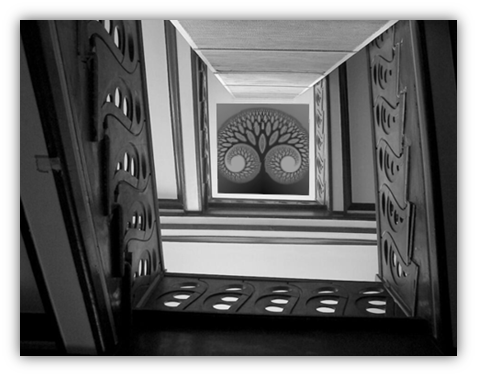As World War I came to a close in November 1918, Germany was in a bad position.
The Allies had defeated the Central Empires, including the German Empire.

With the threat of a naval blockade to prevent food and other goods from entering their country, German representatives were forced to sign a peace treaty on the most unfavorable terms, including occupation of its borders and enormous reparations for the damage dealt to other nations.
Decimated, destitute, and shamed on the world stage, they were teetering on the brink of collapse. They direly needed a new start.
Thus, Germany established its first constitutional republic: the German Reich, later commonly referred to as the Weimar Republic.

This republic took great steps to ensure the equal rights of its citizens, including the lower classes and women.
It was to be a republic of the people, and so the programs and policies it endorsed were made with the people in mind.
That included its sponsorship of the arts.
One of the most notable contributions of the Weimar Republic was the foundation of the State Building House, a.k.a, the Bauhaus. This was a design school dedicated to the practical application of fine arts concepts to craft and architecture.
No more gilded opulence of the wealthy elite; the look of this new Germany would be sleek, modern, and inspiring for all its people.

An example of Bauhaus design.
It was in this promising cultural context that the nation began to release some of the most important motion pictures of the silent film age.
Cinema started off as mere novelty, a means to show off some neat visual tricks. Yet it rapidly transformed into a new form of storytelling and artistic expression.

By the mid 1910s, film directors like D.W. Griffith were releasing epic productions of interweaving visual narratives that could span more than 3 hours.
Fritz Lang released the first cinematic rendition of Madame Butterfly in 1919.
And in 1920, Robert Weine unleashed upon the world what was to be the first example of German Expressionism in cinema, and also perhaps the first horror movie, with The Cabinet of Dr. Caligari.
Written by Hans Janowitz and Carl Mayer, the film centers around the titular Dr. Caligari, a stranger who wreaks havoc on a town and its people, and ruins the life of young Francis, the story’s narrator.

Caligari gains fame at the town carnival by showing off something truly mysterious: a corpselike young man named Cesare who has been sleeping for 23 years.
It soon becomes clear to the audience that Caligari has the power to control this ghoulish somnambulist, who wakes from his sleep to murder anyone the good doctor so desires.

These days, the most legendary aspect of the film is its outrageous visual style. The backgrounds of each scene pop out with cartoonishly twisted surfaces, and a completely off-kilter sense of perspective. Through these warped designs, the film establishes its aspirations as a dark fable, one about tyranny leading to chaos.
Inspired by the paintings of Expressionist artists, the exterior details of Dr. Caligari were crafted to evoke interior emotional states. Whereas Edward Munch used bold brushstrokes to evoke the infinite Scream of nature, the jagged edges and odd curves of Caligari’s set design all help to conjure a man’s state of mind as his life and his world go to ruin.

“What dreadful days I have to live through.
Why are all our buildings so badly put together that tall houses sometimes collapse without any discernible external cause?
I go clambering over the ruins asking everyone I meet, ‘Now how could such a thing happen? In our town – a brand new house – that’s the fifth one today – just think of it!’
And nobody can give me an answer.”
Franz Kafka, Conversation With the Supplicant, 1909
And yet, the main plot of the film is not quite what it seems. Caligari was in fact the first film to employ a twist ending. Sorry-not-sorry for spoiling a film more than 100 years old! Most of the details of the story end up being delusions of poor Francis, who is being held at a mental asylum. The director of the asylum charged with his care is none other than Dr. Caligari.
But rather than conclude that “it was all a dream” by some crazy dude, the film instead ends with ambiguity. Could some of Francis’ fears of his doctor actually be rooted in truth?

Audiences were left pondering and debating this question. The closing shot of the doctor taking care of his patient certainly has some menace to it. And the unresolved ambiguity makes it all even more unsettling.
Also notable is the film’s depiction of mental health facilities, which can shed light on the filmmakers’ take on cultural norms of the day.
For reference, let’s compare it to the Danish documentary film Haxan, which was released two years after Caligari’s surreal portrait of madness.
Haxan’s narrative is centered on the history of mental health practices up to the 20th century, specifically the progression from hunting individuals thought to be witches to the more modern understanding of mental illness and a need for humane treatment. What was thought to be supernatural was now regarded as natural, and practices thought to be good fighting evil looked rather evil itself in retrospect.

Ironically, that film’s theme is truer than the writers could have ever imagined. Haxan makes a solid argument for modernity and humanism, but such cultural shifts are unfortunately not so simple.

It’s no coincidence that many pioneers of mental health practices, such as James McKeen Cattell and Emil Kraeplin, also happened to advocate for eugenic policies to ensure that “inferior stock” did not corrupt the gene pool of the larger populace. Such policies included forced sterilizations and lobotomies of people they considered to be imbeciles, and also blocked the immigration of individuals considered to be from lesser races.
Even the original notion of race, used to justify slavery and colonial dominion, originated as a perceived spiritual difference: treatment of heathens was considered wholly separate from the treatment of fellow Christians. And yet, when African American slaves converted to the religion that supposedly granted dignity to its believers, slave holders then resorted to naturalistic explanations to justify their cruel practices against those converts: a racial hierarchy instead of a religious one.
So, there was indeed an important cultural shift among physicians regarding mental health that expanded and blossomed at the turn of the century, that was no doubt true. But it’s not a fully rosy picture. Whether it was supernatural or naturally derived, power was power. And many of the same power dynamics remained in place, no matter the explanation given for them.
Perhaps even more importantly, modernity also saw a tremendous expansion in the powers of bureaucratic administration to implement a nation’s various social policies. In such a complex system of rules and regulations, the line between care and cruelty can be as crooked and inscrutable as the set design of a German Expressionist film.

“Hey, wake up. They’re talking about us.”
This unnerving aspect of modernity was something that The Cabinet of Dr. Caligari captured quite brilliantly.

The dread and uncertainty that permeate the film were rooted in the horrors of World War I.
The writers saw their Caligari figure as a tyrant who woke a dormant bloodlust, and brought the land into chaos, and so could represent the various leaders who had pushed for Germany to enter the war.
Yet by the end of the film that man is a figure of authority, the head of a facility charged with the care of its patients. And even still, the possibility of his demented nature remains.
Incidentally, the plot twist about the mental asylum had been forced on Janowitz and Mayer by the producers upon suggestion by Fritz Lang; the writers had wanted the story to be a fairly direct warning about the dangers of the authoritarian impulse.

Still, because they never let go of the feeling of uncertainty in terms of what was going on, or of the notion that Herr Caligari might indeed still be a figure of malevolence, their finished product was even better than the original vision: a potent evocation of fragile stability in civilized society.
Not a simple fable wrapped in extravagantly odd clothing, but an uncomfortable glimpse into the more absurd and nightmarish aspects of the modern world.
So, maybe a Munch painting come to life, but also a Kafka story rendered into a visual medium. A work that perfectly captured the cultural tensions of its time, both as a way to process the immediate past, and to foreshadow further nightmares to come.
“One morning, upon awakening from agitated dreams, Gregor Samsa found himself, in his bed, transformed into a monstrous vermin.”
— Franz Kafka, The Metamorphosis, 1915
Kafka’s The Metamorphosis also speaks to the delicate fragility of one’s status in such a rigid and logical bureaucratic society. Like the writers of Caligari, Kafka was from Prague, and he was similarly affected by the chaos of the war. No doubt his Jewish heritage also informed his sense that the systems of German society could easily devour him if they so wished.
And soon enough, those societal systems would be tested again.
A charismatic man would come to wake the nation’s sleeping beast once more. Adolph Hitler joined the National Socialist Party in 1921, and already he was riling up crowds of people, imploring them to seize power and to keep the government free from the influence of Jews, communists, and other malign forces. He blamed Germany’s weakness on decadence, on liberal effeminacy, and on the subversive excesses of the intellectual and artistic elites.

And despite the noble intentions of the Weimar Republic, the systems they put up ultimately would not endure this new test.
And the German people would find themselves sleepwalking into more war and chaos.
Those bureaucratic systems of order and civic function would start to serve absurd and cruel purposes, some of them directly inspired by the eugenic policies of mental health advocates. And so the warped contortions of the town in Caligari rang truer than ever, as did the malevolent caretaker gaslighting his subjects into compliance.
If the writers had followed through on their original idea, perhaps all we would have in Dr. Caligari would be a visually sumptuous and rather flamboyant morality tale, one with an admittedly admirable lesson to convey, but little more than an early template for a Tim Burton film.

More like “Edward Cesare-hands, amirite? No? Fine.”
But because its story as well as its visual design came to embody this uneasy feeling of uncertainty in the modern world, well, now we have something far greater:
The first art film!
While Haxan embraced the naturalistic humanism of modernity, sometimes it makes more sense to get medieval, and to channel your inner holy fool.
Not unlike the many renditions of the trial of Joan of Arc, Dr. Caligari gives us the decidedly nonconformist notion that a person officially declared to be demon-possessed, or insane, might, in fact, be the hero of the story.
Can I get an amen?
Let the author know that you liked their article with a “Green Thumb” Upvote!





Speaking of Dreyer’s film The Passion of Joan of Arc, it was cut and reworked by government censors, and the original master was destroyed in a fire.
But a pristine copy of the original version of the film did somehow survive. In 1981, it was discovered, of all places, in the janitor’s closet of a mental asylum.
Just some random trivia, and yet quite thematically appropriate!
Carl Dreyer: Feminist or accidental feminist?
Do you think the filmmaker was more interested in the spectacle of burning a woman at the stake?
I’ll hold off judging the feminist credentials of someone in the 1920s. But, Dreyer definitely gets some major points off for insisting that Rene Falconetti dig her knees into sharp gravel to get some of those repressed anguish shots. I hate auteur terrible acts like that from directors.
When Selma screams: “I can’t breathe!” I believe her.
I’m so cool I saw The Cabinet of Dr. Caligari when it first came out.
OK, so I’m not quite that old, but I haven’t seen it for almost 45 years and still remember the cubist set design. The odd angles were disturbingly beautiful. That stuck with me, though I don’t really remember the story line. Thanks for the reminder and the detailed analysis.
Probably also a good time to revisit the original film soundtrack:
https://www.youtube.com/watch?v=Y0bR5Q8zZQw
(Hey, it’s true because I say it is. Trust me, I’m a doctor)
I’ve only seen clips of Dr Caligari but the look and set design are stunning. In such a new medium I wonder if audiences at the time found it so striking or just accepted that this is what film could do. Given the horrors of what many had gone through just a few years before it seems to my cosseted modern viewpoint that people would want escapism rather than be presented with something so disturbing. Then again it’s understandable that the horror of WW1 would produce art that is powerful and dark.
Do you know what the contemporary reaction to Dr Caligari was and if it was widely seen?
From what I read, it seems there are some conflicting accounts of how it was received, and part of that was possibly some intentional self-mythologizing about how controversial it was.
Audiences certainly went to go see it, and it was said that women screamed when Cesare looks into the camera. The critical reaction was a bit more mixed, with some people disliking the warped sets. But I think it was at least moderately successful.
It was an art film, but it was also fairly schlocky horror, so, likely more digestible than Dreyer’s Joan of Arc film!
Fascinating as always, Phylum. Really is a treat to read your entries and learn something from them, as well as to be able to consider things in a way I never had before. Thank you for that!
And now I know where the group Bauhaus got its name from – never bothered to educate myself on that before!!! 😄
Also…
Waaait a second, that cover looks familiar…… 🤨
What a crazy full circle on this column!! Totally missed that initial Easter Egg mt, shame on me. ☺️
All credit to our Resident Vanguard for that one.